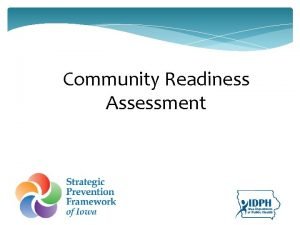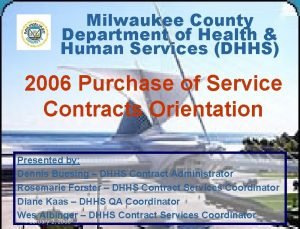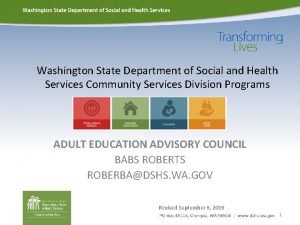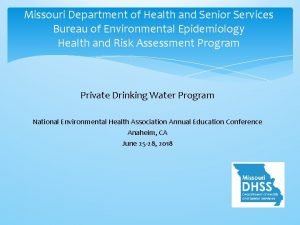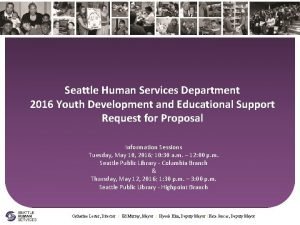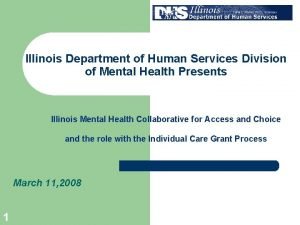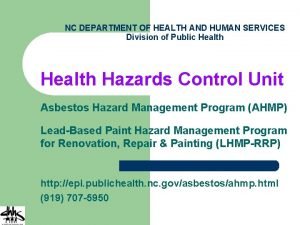NC Department of Health and Human Services Division






- Slides: 6

NC Department of Health and Human Services Division of Aging and Adult Services Updates Joyce Massey-Smith, Director Karey Perez, Adult Service Section Chief

North Carolina DAAS Project Goal: Establish and promote a shared program vision, priorities, and outcomes throughout North Carolina Project Start Oct. 2020 Gathering Trend Data Obtaining Input from Key Stakeholders Understanding DAAS program data and trends Gaining perspective and suggestions for program improvement Dec 2020 Jan. 2021 Interviews in progress. Establishing a Shared Vision and Priorities Achieve consensus on program ‘as-is’, priorities, and a future vision Jan. 2021 Determining a Path Forward Establish recommendations for an actionable path forward Oct. 2020 Interviewing Stakeholders Following up on stakeholder input where appropriate Feb. 2021 A Shared Program Vision Disseminate a shared vision and desired outcomes for North Carolina FINISH

State and County Worker Survey State Program Staff (8%) County DSS Directors (17%) October 2020 County DSS Supervisors 39% County DSS Workers (24%) Training Guidance & Support Partnership & Coordination Extent to which the State training Elements that are most impactful in The quality of the partnership and Alignment of service expectations Suggestions for improving client program and curriculum supports enabling workers serve vulnerable coordination of service provision and actual provision of services. outcomes and prevent workers’ ability to serve vulnerable adults effectively. between the State and counties. Service Expectations Improving Outcomes maltreatment. adults. • The current training program has a moderate to high impact on workers’ ability to serve clients. • Collectively, guidance and supports currently provided by the State is rated good to high. • Recommend focusing on the frequency and location of training opportunities. • Adequacy of funding has the greatest impact on the ability to effectively serve the vulnerable adult population. • Consider mandating training as an essential element of an ideal APS program. • Understanding of general statutes and administrative codes and the internal organizational structure are viewed as important for workers’ to serve clients • Overall partnership and coordination is rated average to good. • Regarding applying state law and policy, inconsistencies exist in the areas of screening APS reports and providing services prior to authorization. • Regarding process related barriers, challenges appear to be predominant in the area of providing services to minimize risks. • Respondents report there is a level of misalignment between the reporter’s expectations for services and the actual services provided to meet the needs of vulnerable adults. • The cause appears to be with the reporter being unfamiliar with the laws and policy and having unrealistic expectations about available services. • Overwhelmingly, State and Counties are focused on doing the right things to strengthen families and prevent adult maltreatment. • To improve outcomes, more focus on making mental health treatment resources available, improve funding, and more community resources. • Most effective elements of the preventive services are inhome aide/PCS and home

Community Service Providers Survey Medical and Health Care (26%) HCBS (9%) Law Enforcement (12%) Aging (13%) LME/MCO (13)% Adult LTC (1%) Advocacy Groups (13%) Improving Outcomes Guidance & Support Partnership & Coordination Elements that are most impactful in enabling The quality of the partnership and Alignment of service expectations and actual Suggestions for improving client outcomes workers serve vulnerable adults effectively. coordination of service provision between the provision of services. and prevent maltreatment. Service Expectations State and counties. • Collectively, guidance and supports currently provided by the state are rated good to high. • Overall partnership and coordination is rated average to good. • Regarding applying state law and • Adequacy of APS resources and policy, inconsistencies exist in the areas funding have the greatest impact on of screening APS reports and the ability to effectively serve vulnerable providing services prior to adult populations. authorization. • Most responders rated NC APS support • Regarding process related barriers, system as moderately or highly challenges appear to be predominant in effective. the area of taking legal or other action to protect vulnerable adults. • The NC APS system consistently adheres to policy. • Overwhelmingly, State and Counties • Respondents report there is a level of are focused on doing the right things misalignment between the reporter's to strengthen families and prevent expectations for services and the actual maltreatment. services provided to meet the needs of vulnerable adults. • To improve outcomes, focus on improving availability of mental health • Respondents indicated the most treatment and community health common cause is unrealistic resources and improve APS funding expectations about available services sources. and resources. • Most effective elements of the preventative services are in-home aide/PCS and special assistance in home/CAP. November 2020

Envisioning Session Planning – Day 1: January 28 th Envisioning Session Objective: Obtain input from stakeholders regarding the establishment of a shared vision, priorities, and outcomes for North Carolina’s APS Program Participants: State and County DSS Stakeholders and Community Service Providers • State Program Staff • County DSS Directors, Supervisors & Workers • Advocacy Groups • Law Enforcement & Judiciary • Aging • Medical & Health Care • HCBS • LME/MCOs • Advocacy Groups Breakout Session #1 Breakout Session #2 Breakout Session #3 Breakout Session #4 • • • Topic Area: Consistency of Practice Topic Area: Stakeholder Engagement Topic Area: Community • Education Topic Area: Unified Statutory Reform AM Session PM Session Breakout Session #1 Breakout Session #2 Breakout Session #3 Breakout Session #4 • • • Topic Area: Consistency of Practice Topic Area: Stakeholder Engagement Topic Area: Community • Education Topic Area: Unified Statutory Reform

Envisioning Session Planning – Day 2: February 4 th Envisioning Session Objective: Review stakeholder input regarding a shared vision, priorities, and outcomes for North Carolina’s APS Program 1. Breakout Session Representatives Report on Discussion Themes from January 28 th Session 01 02 03 2. APS Program Priorities and Vision 3. Recommended Strategies to Implement and Operationalize Change
 Iowa department of health and human services
Iowa department of health and human services Milwaukee county department of health and human services
Milwaukee county department of health and human services Maine department of health and human services
Maine department of health and human services Washington state department of social and health services
Washington state department of social and health services Department of health and senior services missouri
Department of health and senior services missouri Seattle human services department
Seattle human services department Icg grant illinois
Icg grant illinois
